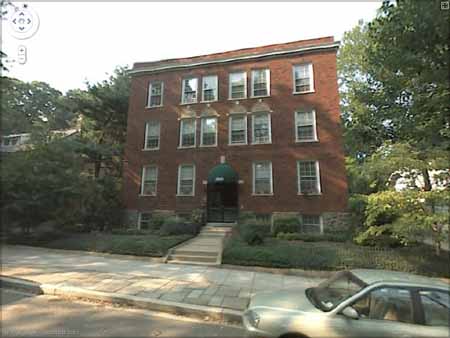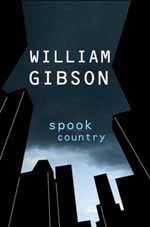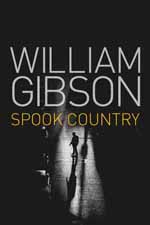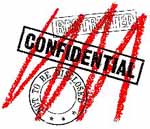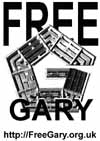Prior to the recent arrest of Kendall and Gwendoline Myers, as long term Cuban
She was a Intelligence Service agents or spies in the USA, (see the previous Spook Country blog entry Alleged Cuban spies in the USA - Walter Kendall Myers and Gwendolyn Steingraber Myers, there was a similar case of a Cuban spy, Anna Belen Montes. Kendall and Gwendoline Myers appears to have admired Anna Montes, but considered her to have been careless with her tradecraft.
The "probable cause for search warrants" affidavit by the FBI (.pdf), in the Anna Montes case, available from the Cryptome website, provides a glimpse of some real world Cuban Intelligence Service espionage tradecraft and secret communications techniques, and of some failings with basic computer security.
It is interesting to compare these real life Cuban espionage tradecraft techniques and FBI counter intelligence countermeasures, to the strict "protocols" described by William Gibson in Spook Country used by the character Tito and his clan of relatives, exiled to the USA, but having been trained by the Cuban DGI and Soviet and East German KGB etc. during the Cold War:
Anna Montes was
...employed by the Defense Intelligence Agency (DIA) as a senior
intelligence analyst. Her current office is at 200 MacDill Boulevard, located on Bolling Air Force Base, Washington, D.C. 20340.[...]
Since 1992, she has specialized in Cuba matters. She is currently the senior analyst responsible for matters pertaining to Cuba.
It may or may not be a coincidence that
6. Records obtained from Riggs Bank reveal that MONTES has continually leased safe
deposit box number 526 at Riggs Bank, N.A., Friendship Branch, 4249 Wisconsin Avenue, N.W., Washington, D.C. since September 2, 1993.
Riggs Bank (now taken over) was deeply involved in various money laundering scandals over the years and the alleged Cuban Spy Gwendoline Meyer worked there as a Management Information Systems analyst.
II. MONTES's Toshiba Laptop Computer and Shortwave Radio
A. Communication From the Cuban Intelligence Service (CuIS) to MONTES via Shortwave Radio
11. Based on my knowledge and familiarity with the methodology of the Cuban intelligence service, I am aware that the CuIS often communicates with clandestine CuIS agents operating outside Cuba by broadcasting encrypted messages at certain high frequencies. Under this method, the CuIS broadcasts on a particular frequency a series of numbers. The clandestine agent, monitoring the message on a shortwave radio, keys in the numbers onto a computer and then uses a diskette containing a decryption program to convert the seemingly random series of numbers into Spanish-language text. This was the methodology employed by some of the defendants convicted last June in the Southern District of Florida of espionage on behalf of Cuba and acting as unregistered agents of Cuba, in the case of United States of America v. Gerardo Hernandez, et al.,Cr. No. 98-721-CR-Lenard(s)(s). Although it is very difficult to decrypt a message without access to the relevant decryption program, once decrypted on the agent's computer the decrypted message resides on the computer's hard drive unless the agent takes careful steps to cleanse the hard drive of the message. Simply "deleting" the file is not sufficient.
13. A receipt obtained from a CompUSA store located in Alexandria, Virginia indicated that on October 5, 1996, one "Ana B. Montes" purchased a refurbished Toshiba laptop computer, model 405CS, serial number 10568512.
14. During a court-authorized surreptitious entry into MONTES's residence, conducted by the FBI on May 25, 2001, FBI agents observed in her residence a Toshiba laptop computer with the serial number set out above. During the search, the agents electronically copied the laptop's hard drive. During subsequent analysis of the copied hard drive, the FBI recovered substantial text that had been deleted from the laptop's hard drive.
In the United Kingdom this sort of legalised burglary is called Intrusive Surveillance Property Interference.
15. The recovered text from the laptop's hard drive included significant portions of a Spanish-language message, which when printed out with standard font comes to approximately 11 pages of text. The recovered portion of the message does not expressly indicate when it was composed.
[...]
16. Portions of the recovered message included the following: "You should go to the WIPE program and destroy that file according to the steps which we discussed during the contact. This is a basic step to take every time you receive a radio message or some disk."
This "basic step"was obviously not always followed by this Cuban spy.
17. During this same search, the agents also observed a Sony shortwave radio stored in a previously opened box on the floor of the bedroom. The agents turned on the radio to confirm that it was operable. Also found was an earpiece that could be utilized with this shortwave radio, allowing the radio to be listened to more privately. Similar earpieces were found in the residences of the defendants in the Hernandez case, as described above in paragraph 11.
18. The recovered portion of the message begins with the following passage:
Nevertheless, I learned that you entered the code communicating that you were having problems with radio reception. The code alone covers a lot, meaning that we do not know specifically what types of difficulty you are having. Given that it's only been a few days since we began the use of new systems, let's not rule out that the problem might be related to them. In that case, I'm going to repeat the necessary steps to take in order to retrieve a message.
The message then describes how the person reading the message should "write the information you send to us and the numbers of the radio messages which you receive." The message later refers to going "to a new line when you get to the group 10 of the numbers that you receive via radio," and still later gives as an "example" a series of groups of numbers: "22333 44444 77645 77647 90909 13425 76490 78399 7865498534." After some further instruction, the message states: "Here the program deciphers the message and it retrieves the text onto the screen, asking you if the text is okay or not." Near the conclusion of the message, there is the statement "In this shipment you will receive the following disks: . . . 2) Disk "R1" to decipher our mailings and radio."
19. Further analysis of MONTES's copied Toshiba hard drive identified text consisting of a series of 150 5-number groups. The text begins, "30107 24624," and continues until 150 such groups are listed. The FBI has determined that the precise same numbers, in the precise same order, were broadcast on February 6, 1999, at AM frequency 7887 kHz, by a woman speaking Spanish, who introduced the broadcast with the words "Attencion! Attencion!" The frequency used in that February 1999 broadcast is within the frequency range of the shortwave radio observed in MONTES's residence on May 25, 2001.
See the Wikipedia entry on the Cuban Atención Numbers Station
B. Communication Between the CuIS and MONTES via Computer Diskette
20. Based on my knowledge of the methodology employed by the CuIS, I am aware that a clandestine CuIS agent often communicates with his or her handling CuIS officer by typing a message onto a computer, and then encrypting and saving it to a diskette. The agent thereafter physically delivers the diskette, either directly or indirectly, to the officer. In addition, as an alternative to sending an encrypted shortwave radio broadcast, a CuIS officer often will similarly place an encrypted message onto a diskette and again simply physically deliver the diskette, clandestinely, to the agent. Upon receipt of the encrypted message, either by the CuIS officer or the agent, the recipient employs a decryption program contained on a separate diskette to decrypt the message. The exchange of diskettes containing encrypted messages, and the use of decryption programs contained on separate diskettes, was one of the clandestine communication techniques utilized by the defendants in the Hernandez case described above in paragraph 11. Although it is difficult to decrypt a message without the decryption program, the very process of encrypting or decrypting a message on a computer causes a decrypted copy of the message to be placed on the computer's hard drive. Unless affirmative steps are taken to cleanse the hard drive, beyond simply "deleting" the message, the message can be retrieved from the hard drive.
This is a basic computer security mistake, which could have been mitgated ,perhaps, by using a volatile RAM disk to store the tempory de-cryption results, or a locally encrypted encrypted container file, partition or hard disk, to store the plaintext of the messages to and from the Cuban Intelligence Service (CuIS) e.g. nowadays, using something like TrueCrypt
What is true for foreign intelligence agents or spies, is also true for anyone else who wants to hide secrets from the Government or its agencies e,.g. criminals and terrorists, but also legitimate , if suppressed, investigative journalists, bloggers , whistleblowers and political activists or dissidents.
21. Based on the evidence described below, I have concluded that MONTES was a CuIS agent who communicated with her CuIS handling officer by passing and receiving computer diskettes containing encrypted messages.
22. The message described above that was contained on the hard drive of MONTES's laptop computer contained the following passage:
Continue writing along the same lines you have so far, but cipher the information every time you do, so that you do not leave prepared information that is not ciphered in the house. This is the most sensitive and compromising information that you hold. We realize that this entails the difficulty of not being able to revise or consult what was written previously before each shipment, but we think it is worth taking this provisional measure. It is not a problem for us if some intelligence element comes repeated or with another defect which obviously cannot help, we understand this perfectly.-- Give "E" only the ciphered disks. Do not give, for the time being, printed or photographed material. Keep the materials which you can justify keeping until we agree that you can deliver them.-- Keep up the measure of formatting the disks we send you with couriers or letters as soon as possible, leaving conventional notes as reminders only of those things to reply to or report.
The message goes on to refer to a "shipment" that contains "Disk 'S1' - to cipher the information you send," and, as indicated in the previous section, to "Disk 'R1' to decipher our mailings and radio." Earlier in the message, there is a reference to "information you receive either via radio or disk."
23. During the court-authorized search of the residence on May 25, 2001, two boxes containing a total of 16 diskettes were observed. During a subsequent such search on August 8, 2001, a box containing 41 diskettes, later determined to be blank, were observed. Finally, records obtained from a Radio Shack store located near MONTES's residence indicate that MONTES purchased 160 floppy diskettes during the period May 1, 1993, to November 2, 1997.
Presumably the floppy diskette message Encryption Diskette S1and the Atención Numbers radio broadcast Decryption Diskette R!, contain one time pad blocks of random numbers (theoretically unbreakable through cryptanalysis, but prone to human errors if used purely manually0, with which to encrypt or decrypt the relatively low volume of message data being sent.
Purchasing lots of Floppy Diskette's from the one local Radio Shack store was obviously also a tradecraft mistake. Ana Montes must have used a credit card, or filled out some sort of invoice or marketing questionnaire, for such relatively small purchases of floppy diskettes (which usually came in boxes of 10) to be traced to her.
III. Communication from MONTES to the CuIS by Pager
24. Based on my knowledge of the methodology employed by the CuIS, I am aware that a
clandestine CuIS agent often communicates with his or her handling CuIS officer by making calls to a pager number from a pay telephone booth and entering a pre-assigned code to convey a particular message. This methodology was utilized by the defendants in the Hernandez case described above in paragraph 11.25. Based on the evidence described below, I believe that MONTES has been communicating with her handling CuIS officer in this fashion.
26. In the same message copied from MONTES's hard drive that has been described earlier in this affidavit, there is a passage that states:
C) Beepers that you have. The only beepers in use at present are the following: 1) (917) [first seven-digit telephone number omitted from this application], use it with identification code 635. 2) (917) [second seven-digit telephone number omitted from this application]. Use it with identification code 937. 3) (917) [third seven-digit telephone
number omitted from this application] Use it only with identification code 2900 . . . because this beeper is public, in other words it is known to belong to the Cuban Mission at the UN and we assume there is some control over it. You may use this beeper only in the event you cannot communicate with those mentioned in 1) and 2), which are secure.Based on my experience and knowledge, I have concluded that the reference to "control over it" in the above passage refers to the CuIS officer's suspicion that the FBI is aware that this beeper number is associated with the Cuban government and is monitoring it in some fashion.
27. In addition, as described previously, the message on the laptop's hard drive includes a portion stating that the message recipient "entered the code communicating that you were having problems with radio reception." Based on the evidence described above, I have concluded this portion of the message indicates that MONTES at some point shortly prior to receiving the message sent a page to her CuIS officer handler consisting of a pre-assigned series of numbers to indicate she was having communication problems.
[...]
Pagers are limited by the short numeric or alphanumeric message capability, and the need to use a telephone to send such a message, usually via a human operated switchboard or perhaps a touch tone phone.
The advantage is that the receipt of such a pager beep is , effectively untraceable, as the radio signal covers a very wide geographical area.
A disadvantage is that, obviously, intelligence agencies monitor the Communications Traffic Data i.e. to whom the particular Pager unit was sold to / rregistered in the name of, andthe time and date (and landline or mobile cell phone number setting up the pager message), and Intercepting the plaintext, unencrypted content of the pager messages themselves,which is also listened to by amateur radio hams, using protocol decoding software available for free from the internet e.g. POCSAG and Flex pager protocol decoders.
FBI Physical Surveillance of MONTES and Telephone Records for May to September 2001
38. FBI physical surveillance of MONTES has shown a recent pattern of pay telephone calls by her to a pager number, a communication method that, as described above in paragraph 24, is consistent with known CuIS communications plans and operations. In each paragraph below that refers to MONTES driving, she was utilizing the Toyota described above in paragraph 2.
39. The FBI maintained periodic physical surveillance of MONTES during the period May to September 2001. On May 20, 2001, MONTES left her residence and drove to the Hecht's on Wisconsin Avenue, in Chevy Chase, Maryland. She entered the store at 1:07 p.m. and exited by the rear entrance at 1:27 p.m. She then sat down on a stone wall outside the rear entrance and waited for approximately two minutes. At 1:30 p.m., the FBI observed her walk to a pay phone approximately 20 feet from where she was sitting. She placed a one minute call to a pager number using a pre-paid calling card. At 1:45 p.m. she drove out of the Hecht's lot and headed north on Wisconsin Avenue toward Bethesda, Maryland. At 1:52 p.m. she parked her car in a lot and went into Modell's Sporting Goods store. She quickly exited the store carrying a bag and crossed Wisconsin Avenue to an Exxon station. She was observed looking over her right and left shoulders as she crossed the Exxon lot. At 2:00 p.m. she placed a one minute call from a pay phone at the Exxon station to the same pager number using the same pre-paid calling card. By 2:08 p.m.,MONTES had walked back to her vehicle and was driving back to her residence where she arrived at 2:30 p.m.
Note the use of Pay Phones, with a Pre-Paid Calling Card for the short (one minute) calls to the Paging Service number.
This was also, obviously, a tradecraft mistake, since Pre-Paid Calling Cards all have a unique serial number / account code, which provides evidence that a particular series of calls, even from different public telephones, are actually linked together.
Perhaps she should have used coins (taking care not to leave fingerprints and DNA samples etc.), although,of course,since Montes was under physical Directed Surveillance by the FBI, it was already too late for her by then.
40. On June 3, 2001, MONTES engaged in similar communications activity. She left her residence at approximately 2:30 p.m. and drove to a bank parking lot at the corner of Harrison Street, N.W. and Wisconsin Avenue, N.W. She exited her car at approximately 2:37 pm and entered a Borders Book Store on Wisconsin Avenue. She left the store approximately 40 minutes later. She then crossed Wisconsin Avenue to the vicinity of three public pay phones near the southern exit of the Friendship Heights Metro Station. At 3:28 p.m. she placed a one-minute call using the same pre-paid calling card to the same pager number she had called on May 20, 2001. After a few minutes, she walked back to her car and drove to a grocery store.
41. Pursuant to court authorization, on August 16, 2001, the FBI searched MONTES's pocketbook. In a separate compartment of MONTES's wallet, the FBI found the pre-paid calling card used to place the calls on May 20, 2001 and June 3, 2001. In the same small compartment, the FBI located a slip of paper on which was written the pager number she had called. Written above this pager number was a set of digits that I believe comprise one or more codes for MONTES to use after calling the pager number, i.e., after contacting the pager, she keys in a code to be sent to the pager which communicates a particular pre-established message.
So, not only the Pre-Paid Phone Calling Card, but he actual content of some or all of the messages sent to the Pager service were found in her possession,nearly 3 months after these messages had been set.
Poor tradecraft again.
42. On August 26, 2001, at approximately 10:00 a.m., the FBI observed MONTES making a brief pay telephone call to the same pager number from a gas station/convenience store located at the intersection of Connecticut and Nebraska Avenues, N.W., in Washington, D.C.
43. On September 14, 2001, MONTES left work and drove directly to her residence. She then walked to Connecticut Avenue, N.W., in Washington, D.C., still wearing her business clothes, and made a stop at a dry cleaning shop. She then entered the National Zoo through the Connecticut Avenue entrance. She proceeded to the "Prairie Land" overlook where she stayed for only 30 seconds. She then walked further into the zoo compound and basically re-traced her route out of the zoo. At approximately 6:30 p.m. MONTES removed a small piece of paper or card from her wallet and walked to a public phone booth located just outside the pedestrian entrance to the zoo MONTES then made what telephone records confirmed to be two calls to the same pager number she had called in May, June and August, as described above. The records reflect that the first call was unsuccessful, i.e., the call lasted zero seconds. According to the records, she made a second call one minute later that lasted 33 seconds. Shortly after making these calls, MONTES looked at her watch and then proceeded to walk back to her residence.
43. On September 15, 2001, telephone records pertaining to the pre-paid calling card number on the card observed in her pocketbook on August 16, 2001, show that MONTES made a call to the same pager number at 11:12 a.m. that lasted one minute.
44. On September 16, 2001, MONTES left her residence in the early afternoon and took the Metro (Red Line) to the Van Ness - UDC station in Washington, D.C. She made a brief telephone call from a payphone in the Metro station at approximately 1:50 p.m., again to the same pager number
Just as in fiction, it seems, use was made of a Zoo, for clandestine espionage related communications. The National Zoological Gardens are a few hundred metres from Ana Montes's apartment (see ATTACHMENT A below)
45. MONTES is known to possess a cell phone. A cell phone was observed during a court-authorized search of her tote bag on August 16, 2001.
How exactly was her pocketbook and tote bag searched in August 16th 2001 ? Was this another "surreptitious entry" into her residence, like on May 25th, presumably whilst she was asleep, or was there some sort of pickpocketing ?
In addition, during surveillance on September 16, 2001, MONTES was observed speaking on a cell phone. Furthermore, telephone records obtained in May 2001 confirm that she has subscribed to cell telephone service continually from October 26, 1996 to May 14, 2001. MONTES's use of public pay phones notwithstanding her access o a cell phone supports my conclusion that the pay phone calls described in this section were in furtherance of MONTES's espionage.
Another example, wherenot using your mobile cell phone, is regarded as suspicious behavior, by law enforcement or intelligence agencies (correctly, in this case).
The list of "espionage paraphernalia" which the FBI was granted search warrants for:
ATTACHMENT B
1. Espionage paraphernalia, including devices designed to conceal and transmit national defense and classified intelligence information and material, and implements used by espionage agents to communicate with their handlers and with a foreign government, to wit: white tape, mailing tape, colored chalk (all used for signaling purposes), coded pads, secret writing paper, microdots, any letters, notes or other written communications (including contact instructions) between defendant ANA BELEN MONTES and any agents of the CuIS or other intelligence service of Cuba; any computers, (including laptops), computer disks, cameras, film, codes, telephone numbers, maps, photographs and other materials relating to communication procedures, correspondence;
2. Records, notes, calendars, journals, maps, instructions, and classified documents and other papers and documents relating to the transmittal of national defense and classified intelligence information (including the identities of foreign espionage agents and intelligence officers and other foreign assets or sources providing information to the United States Intelligence Community, such as the FBI and CIA; records of previous illicit espionage transactions, national defense transactions, national defense and classified intelligence information, including copies of documents copied or downloaded by ANA BELEN MONTES from the DIA);
3. Passports, visas, calendars, date books, address books, credit card, hotel receipts and airline records, reflecting travel in furtherance of espionage activities;
4. Identity documents, including but not limited to passports, licenses, visas (including those in fictitious or alias identities), U.S. and foreign currency, instructions, maps, photographs, U.S. and foreign bank account access numbers and instructions and other papers and materials relating to emergency contact procedures and escape routes;
5. Safety deposit box records, including signature cards, bills, and payment records, safety deposit box keys, whether in the name of the defendant or a family member; any records pertaining to any commercial storage sites where the defendant may be storing other classified intelligence and counter-intelligence documents or other records of her espionage activities;
6. Federal, state and local tax returns, work sheets, W-2 forms, 1099 forms, and any related schedules;
7. Telephone bills and records, including calling cards and pager records;
8. Photographs, including photographs of co-conspirators; correspondence (including envelopes) to and from ANA BELEN MONTES and handlers, contacts and intelligence agents of Cuba;
9. Computer hardware, software, and storage media, known to be used by the defendant or to which she had access, including, but not limited to: any personal computer, laptop computer, modem, and server, which have been and are being used to commit the offenses of espionage and conspiracy to commit espionage; records, information and files contained within such computer hardware containing evidence and fruits of defendant's espionage activity between October 5, 1996, and the present, including classified documents, in whatever form and by whatever means they have
been created or stored, including but not limited to any electrical, electronic, or magnetic form of storage device; floppy diskettes, hard disks, zip disks, CD-ROMs, optical discs, backup tapes, printer buffers, smart cards, memory calculators, pagers, personal digital assistants such as Palm III devices, removable hard drives, memory cards, zip drives, and any photographic forms of such records including microfilm, digital prints, slides, negatives, microfiche, photocopies, and videotapes, computer terminals and printers used by the defendant in said espionage activity.
ATTACHMENT A
The residence of ANA BELEN MONTES is located at 3039 Macomb Street, N.W., apartment 20, Washington, D.C. 20008. 3039 Macomb Street, N.W., is titled "The Cleveland Apartments," and is a three story, red brick building. Apartment 20 is on the second floor and is the first door on the left.
Will this become a tourist attraction on a Spies of Washington Tour ?
Google Streetview location map and pan tilt zoom photo of 3039 Macomb Street N.W. Washington, D.C. 20008
